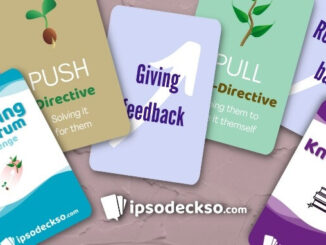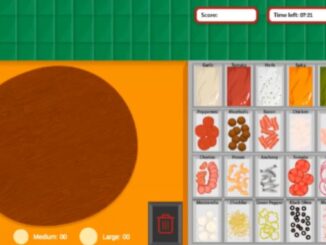
Building a multi-player training simulation game for Change Management – from scratch and against many odds
0: Here we go
Day Number Zero
It all started one day with one of our corporate clients asking us, “Can you do something different next month?” There was vagueness in the request and desperation in the tone.
They had done enough PowerPoint-driven sessions. L&D was frustrated, business managers were bored and participants were mutinous. They were all at the end of their tether. All they wanted was something different. Anything different. We had an idea.
Game-based Learning is what we felt we should try. We thought we could design a quick game to facilitate a session on Change Management. This is the story of how it came to life – from Idea to Prototype and finally to Finished Product.
1, 2, 3, 4: The Storm before the Calm
One office. Two people. Three hours a day. Four days.
All we did was brainstorm ideas and eat pizzas – lots of both. Beyond the discussions at the office, we were on calls throughout these four days.
Some themes that stand out in my memory involved space travel, sailing across a pirate-infested sea, building a settlement on an island, war prep against a tyrant, building a startup, running a restaurant, and a race to the North Pole.
Somewhere there, we had thought of a game about Running an Organic Farm too. In all fairness, it felt like a very (how do you say) “uninspiring” game. All the other theme ideas seemed much more epic in their scope as well as meaning. I still have no idea why, then, we were drawn to the Farming theme.
In hindsight, I am glad we were. The idea provided so many possibilities and so many real-life inspirations. I can’t think of any of the other themes which could have given us so many facets to work with.

5, 6, 7, 8: Let’s dance
To the tunes of every constraint
The next four days went in interviewing a wide variety of people and making tons of notes. We spoke to L&D and IT departments. We spoke to potential participants and their managers. We spoke to game designers and graphic artists. We spoke to coders and database designers.
Each conversation took us farther from any form of consensus. There were new constraints, contradictions and conflicts unearthed at each step. We had to keep in mind, among other things, the requirements put forth by L&D, participant interest (or sometimes lack thereof), shortcomings of the platforms approved by IT, and worst of all, Internet bandwidth issues due to participants spread all across the world during the pandemic.
This is what the requirement document looked like. (It was enough to make grownups cry):
- The game has to be played collaboratively – but must have some competitive elements
- The game has to be played strategically – but must have some elements of chance
- The game must include all participants who are present – but not mandate their presence
- There must be clearly assigned roles – but the game shouldn’t stop if someone drops out

9 to 11: Run away? Or run with it?
In India, 9-2-11 is a colloquialism that literally means to run away. Don’t ask why!
For a while, we seriously considered declining the project. After investing so much time and energy in it, the roadblocks seemed too many to deliver anything worthwhile. We agree that “Creativity stems from Constraints”, but surely there has to be a limit after which they just become a hindrance and not worthwhile anymore.
Good sense prevailed though. A little because it was a long term relationship with this client, and a little because we had come to love the hundreds of hand-sketches and notes enough to want to see the game in action. But, mostly because we got on board a wonderful game designer. Shoutout to Psy Sai.
With her creative input and long hours of discussion, we found an answer to pretty much every question that was troubling us.

12, 13, 14, 15: The Grind
The days are a blur, but the game becomes clearer
After much discussion, making, testing, breaking, remaking, here’s how our erstwhile hopeless requirement document had become. Some aspect of the game addressed every constraint and turned it into a strength.
- A team of 4-5 people will manage a farm each. There will be multiple teams simultaneously managing their own farms. They’ll play collaboratively within their farm, while competing with other teams. Collaborative & Competitive: Check
- The game has decisions to make about cost of sowing, duration of harvest, revenue from the yield, matching vegetables to soil types – all strategic decisions. Investment decisions are to be made to improve profits, protect against disasters, get intel about weather and general consultation/advice – still very much strategic. Market demands fluctuate, and weather and other disasters wreak havoc – all of which depend on chance/randomness. Some you can plan to mitigate, others are out of your control. Strategy & Chance: Check
- Due to obvious internet bandwidth issues, we decided to not make the game turn-based. Instead the game time keeps running in the background. Every 10 seconds represent one game day, and if even one player in the team is online, the clock keeps ticking (and the calendar keeps flipping). Everyone can play, but no one is missed if they are missing. The game goes on. Everyone Involved & Everyone Not Mandatory: Check
- Everyone can discuss and decide. Everyone can sow and harvest. Everyone can invest and liaise. Clear roles can be picked from a list and adhered to as an agreement between the teammates. But the game puts no restrictions on who can do what. Roles are suggested, even encouraged, but never imposed. That way, if someone with a specific role drops out, the game doesn’t come to a standstill awaiting that person to join back. Role & No role: Check
A game was born. Those four days of work had created a game so well-rounded that even after nine months of continuous tinkering, it has retained much of its original essence.
16: Bittersweet emotional day
You win some, you lose some
One of our big advantages is that we have a solid tech background as I have run a software development company for a decade. Our prototypes aren’t built on Miro or Google Docs or other collaborative tools. Instead, we code them as standalone software. The benefit here is that when the game is done, it’s done. Nowhere else to go. No one else to talk to. Nothing else to do.
The prototype is ready to use – pretty much right away. In the past, this approach used to take us a little longer than using publicly available platforms, but now we have enough pieces of the puzzle ready that we can assemble our software in days and weeks, rather than months.
Anyway, we present the product to the client. They absolutely love it: the attention to detail, the turnaround time, the debrief possibilities. They love everything about the game. We have a deal.
This felt too good to be true. And, it was.
Last week, their IT department decided to ban Zoom. Unfortunately, MS Teams didn’t have breakout rooms (at that time). How the hell do you play this game without putting people into breakout rooms? We felt… well I can’t put in words what we felt – not in print at least.

17, 18, 19, 20: The Grind (Again)
Communication is the Lock!
The most amazing game we had created to date could potentially not get used by the client who commissioned (and loved) it because their IT department made some decision. In hindsight, 20/20 as it is, I can’t thank the IT department enough for their contribution in the form of this new constraint. While it pushed us to our limits, it made the product that much better.
Our two-week timeline was now shot to smithereens. We were back to the drawing table. We tried and tested dozens of options, while the most obvious solution to the “No Breakout Rooms Allowed” problem patiently awaited discovery right under our noses.
Two days later, after discarding one hare-brained idea after the other, we finally saw it. We had to create our own chat system – deeply integrated into the game. The actual work itself was pretty simple – once the idea was approved. We added text and voice chat into the game. People could now communicate with their own team as well as with the facilitator using it.

We tested it over the next few days, and found it worked like a charm. Due to a few other IT constraints, we have now put audio chat on hold, but the text chat has proven adequate to scale the last, seemingly insurmountable mountain.
21, …, Today: Here we are
The Home Stretch and WIP forever
We have a game that is fun for the players to play, even more fun for the facilitators to facilitate and different (and more impactful) for the L&D Department. We have a win-win-win product which is creating quite a buzz wherever it goes, and we can’t be prouder of it.
This is how the Player View looks with some portions trimmed for brevity.

There is also a robust back-end Facilitator View to manage the game. It can be used to change market demands, bring disasters on demand, see everyone’s chat, move people around in teams, allow/block investments, pause/speed up/slow down the game and many more things.
More changes are on the way, the next one is code-named The Four Seasons and deals with automations relevant to Seasons. So Farm So Good (SFSG) is an agile game – not just in the way it is played or facilitated – but also in the continuous improvements we are making to it.
Creativity does stem from Constraints. The more the better. Also, #WIPForever
A live play session of So Farm So Good featured in our Make and Break sessions. Watch it there.
- So Farm So Good – from zero to ‘done’ in 21 days - 19th September 2021





Be the first to comment